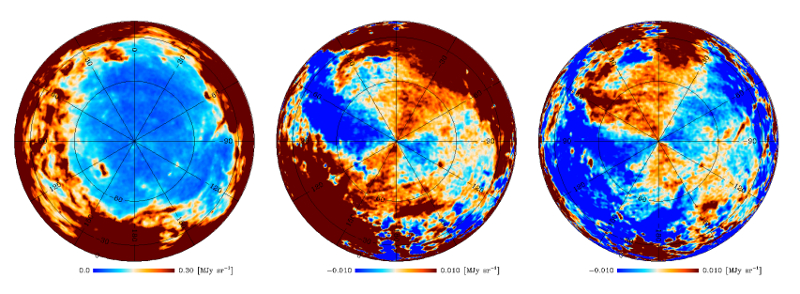| EPoS Contribution |
|
The structure of the Galactic magnetic field in the diffuse ISM with Planck
Andrea Bracco AIM, CEA Saclay, Paris-Saclay, FR | |
|
Magnetic fields are fundamental ingredients to investigate the dynamics of the interstellar medium (ISM). However, the properties of the Galactic magnetic field (GMF) are yet to be thoroughly understood. Nowadays, the Planck polarization data at submm wavelengths offer a unique chance to probe the GMF orientation over the whole sky. Using this unprecedented dataset, I will present the first attempt in characterizing the GMF structure in the solar neighborhood by quantifying its effects on the statistical properties of the dust polarization fraction and angle at high-Galactic latitude (b < -60 deg).
The Stokes Q and U maps at 353 GHz reveal patterns at large angular scales, which can be explained by a geometric model of the GMF that only accounts for a uniform direction pointing towards the Galactic coordinates (l,b)=(70 +-10, 24 +- 20) deg, in agreement with previous works based on starlight polarization. In addition to these regular patterns expected for a mean-field direction, a significant scatter in the polarization angle is also observed, as well as a wide distribution of the polarization fraction. Why is so? I will show that the answer to this question can be found in the turbulent component of the GMF, which we characterize with a phenomenological model. The variation of the field orientation along the line of sight, caused by turbulence in the ISM, plays a crucial role in our interpretation of the observed dispersion of the polarization parameters. We account for this effect by building Stokes parameter maps summed over a discrete set of polarization layers, all of which are obtained with Gaussian realizations of a power-law power spectrum. We are able to reproduce the observed distributions of polarization angle and fraction considering only a few independent polarization layers along the line of sight and equipartition between turbulent-kinetic energy and magnetic energy in the diffuse ISM. I will also discuss possible physical interpretations of our polarization layers based on the density structure and on the correlation length of the magnetic field along the line of sight. This work, which I will present on behalf of the Planck collaboration, will be soon submitted for publication. | |
 | |
| Caption: Orthographic projections centered on the south Galactic pole of the Planck dust emission intensity, D353 (left), the Stokes Q353 (center), and U353 (right) maps at 353 GHz. A grid of Galactic coordinates in degrees is included. The U353 map is in HEALPix convention, which corresponds to −U353 in IAU convention. | |
| Collaborators: Planck Collaboration |
Suggested Session:
Magnetic Fields |

